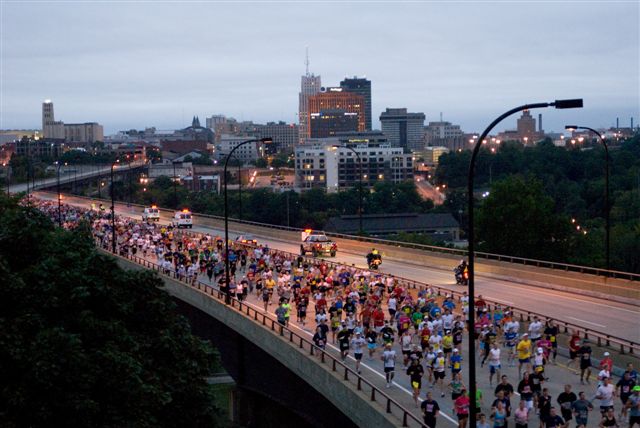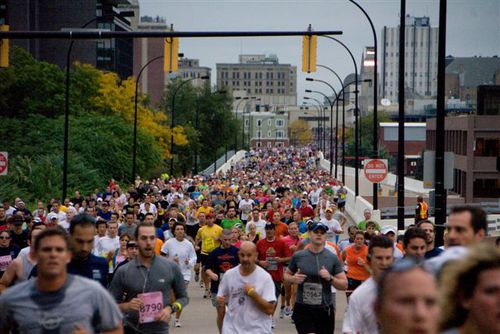
We thank David for his story telling, his love of his city and his love of our sport. Watch for more pieces from David Hunter over the next few months!
From Akron to AkRUN: One Marathon’s Journey
(Part 4 of a 4 Part Series):
RelatedPosts
Coming Attractions
We can’t figure out if our journey to date has been a quick jaunt or an ultra marathon. On the one hand, it is hard to believe that next year will already witness the 10th running of the Akron Marathon. Yet, on the other hand, during our extended trek through our first decade, our city and our race leadership accomplished much: we hosted two international road race championships, staged one national women’s championship road race, nearly missed landing the opportunity to host a U.S. Olympic Trials Marathon, and grew our race day participant total from slightly over 3,500 to more than 14,000 in nine years.
Make no mistake, our race organizers are gratified with what’s been accomplished to date. But we don’t dwell on it. We are busy focusing on creating a great sporting event and gala celebration on September 29, 2012 – the 10th running of the Akron Marathon.
Helping to shape our efforts have been several economic impact studies which have been assembled by one of the heads of the Economics Department of the University of Akron. The recently-released study of the 2011 race reveals that the total spending impact of the race weekend in our region was a sparkling $5.25 million. While this is an impressive number for a mid-sized Midwestern city – Akron’s population is approximately 210,000 – even more impressive is the fact that this statistic increased 30% from the prior year. Further, the sophisticated report – which employs a comprehensive calculation of direct and indirect spending – further noted that the race weekend stimulated the formation of nearly four dozen new full-time jobs in Akron. Hey, we’re a “job creator”! Lastly, and perhaps most importantly, this upbeat economic study serves as a welcomed validation of the city’s decision to provide broad-based in-kind support for our organizational and race weekend efforts. Quite simply, the economic impact study provides irrefutable political cover for our mayor who believed in the event from its inception and was courageous enough to provide the type of extensive support that has helped make the Akron Marathon what it is today. The economic impact study proves the mayor’s bold decision to provide city support was the right move.
So what is next? First of all, inspired by the encouraging economic impact study, we are working to expand the footprint of our event – both the days our event covers, as well as the sectors of greater Akron it touches. We are inspired by Louisville, Kentucky – a city where each May an entire week of exciting and varied events are borne out of a two-minute horse race! With our race traditionally run on Saturday morning and knowing how post-race marathoners love to party, we have plans in the works to create a multiple-sited Saturday evening musical celebration (think Memphis’s Beale Street). Named with a nod to our 26 mile, 385 yard blue line, “Paint The Town Blue” can create an ideal venue for our runners – who have trained with disciplined focus for months – to engage in a little post-race revelry in the city that gave you Devo, Chrissie Hynde, and The Black Keys.
With a longer vision, we also want to lay the groundwork for identifying and partnering with a “sister marathon”. For several years Akron has had a special reciprocal relationship with Chemnitz, Germany which has involved a certain degree of trade and cultural exchanges – and even some runner reciprocity. The concept of partnering with this or another city to exchange runners not only would help our event but also would add some spice to our partnering city and help the sport in general.
The Akron Marathon is working to develop a mutually-beneficial relationship with a major marathon under a type of “Gateway” program. The concept would be to work in tandem with a large sold-out marathon to encourage its turned-away applicants to run the Akron Marathon as a pathway for guaranteed entry to the participating major marathon the following year. Both marathons stand to gain through such partnering. A Gateway program – which can be made to be economically beneficial to both participating races – would reflect favorably on the major marathon. These mega-races – which annually disappoint tens of thousands of aspiring marathon participants when their applications are denied – could suddenly present a positive option: a top-flight alternative marathon opportunity and a guaranteed entry into the larger urban marathon the following year. Of course, a Gateway program would obviously help our up-and-coming marathon which is naturally seeking – and could easily accommodate – more runners. Providing an encouraging race alternative to dejected, would-be entrants who have been turned-away by the large urban marathons would help promote fitness, boost marathon participation, and generally be positive for the sport of running in the United States.
As the Akron Marathon grows each year, we continue to search for ways to make a stronger and more expanded positive impact – not limited merely to the sport of running. The Akron Marathon is committed to directing time and resources to promote an overall healthy lifestyle – one component of which would, of course, be the type of regular cardiovascular exercise that can be offered through sensible year-round running. No city marathon is better situated to embrace this healthy lifestyle component than Akron. Northeastern Ohio is the home of an inordinate number of highly-respected healthcare organizations, several of which have stellar international reputations. The willingness of these enlightened health care organizations to work together with the Akron Marathon (e.g. partnering to promote healthy lifestyles; to better address the obesity epidemic; etc.) becomes more evident every year – and the perceived upside impact of such collaboration has the potential to be truly significant.
Civic philanthropy has to be an ever-increasing element of the Akron Marathon as we head into our second decade. Aided by the generosity of others during our earlier years, the Akron Marathon is committed to honor this past support by paying it forward. While the economic growth of the race is still in its infancy, the Akron Marathon Charitable Corporation – the nonprofit corporation which runs the organization – has been able annually to dedicate revenues for charitable purposes. And it is committed to increase its civic philanthropy yearly.
While the economic recovery of our country has been and will continue to be a long slog, there are detectible indications of modest economic improvement – even in our manufacturing-laden region. This encourages and inspires us to find effective ways to resume collaboration with USA Track & Field in hosting future national road racing events.
The recognition of all of these opportunities that surround us invigorates our race leadership team and makes it easy for us to sidestep any tendency toward complacency. We often conclude our planning meetings with the hopeful remark “We’re getting there”. But in reality, and in our heart of hearts, we know that there is no “there” there. With each accomplishment, our eyes are opened to even more we could – and should – be doing. It reminds me of one of my favorite runni
ng posters – a solitary runner knocking out miles on a desolate highway in the deserts of southern Utah. The poster caption reads “There is no finish line”. That’s alright. It’s not about the destination. It’s about the journey. Dave Hunter
[You can learn more about the Akron Marathon at www.akronmarathon.org. The writer, who can be emailed at: dhunter@brouse.com, has raced over 90 marathons, including the 1983 BAA Marathon where he set his PR of 2:31:40.]
[822218.3]
Author

Larry Eder has had a 52-year involvement in the sport of athletics. Larry has experienced the sport as an athlete, coach, magazine publisher, and now, journalist and blogger. His first article, on Don Bowden, America's first sub-4 minute miler, was published in RW in 1983. Larry has published several magazines on athletics, from American Athletics to the U.S. version of Spikes magazine. He currently manages the content and marketing development of the RunningNetwork, The Shoe Addicts, and RunBlogRun. Of RunBlogRun, his daily pilgrimage with the sport, Larry says: "I have to admit, I love traveling to far away meets, writing about the sport I love, and the athletes I respect, for my readers at runblogrun.com, the most of anything I have ever done, except, maybe running itself." Also does some updates for BBC Sports at key events, which he truly enjoys. Theme song: Greg Allman, " I'm no Angel."
View all posts



















